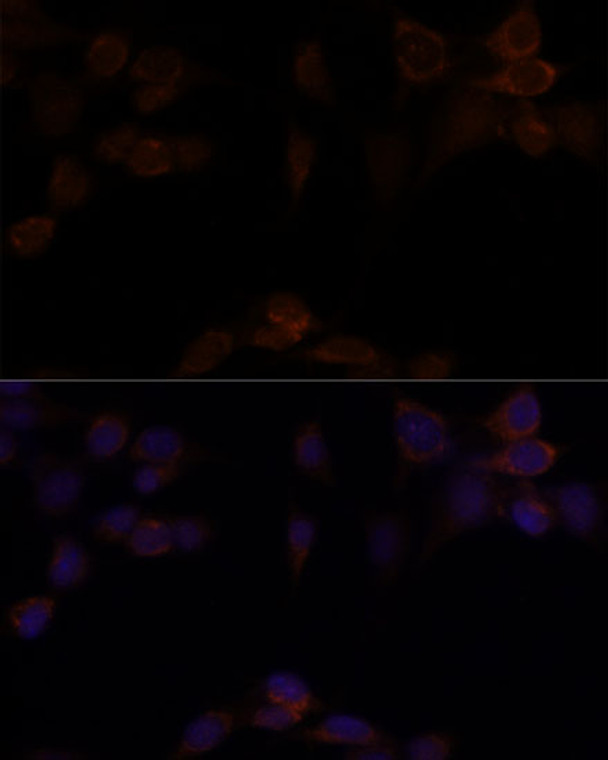| Host: |
Rabbit |
| Applications: |
WB/IHC-P/IF/ICC/ELISA |
| Reactivity: |
Human/Mouse/Rat |
| Note: |
STRICTLY FOR FURTHER SCIENTIFIC RESEARCH USE ONLY (RUO). MUST NOT TO BE USED IN DIAGNOSTIC OR THERAPEUTIC APPLICATIONS. |
| Clonality: |
Polyclonal |
| Conjugation: |
Unconjugated |
| Isotype: |
IgG |
| Formulation: |
PBS with 0.02% Sodium Azide, 50% Glycerol, pH 7.3. |
| Purification: |
Affinity purification |
| Concentration: |
Lot specific |
| Dilution Range: |
WB:1:500-1:1000IHC-P:1:50-1:100IF/ICC:1:50-1:200ELISA:Recommended starting concentration is 1 Mu g/mL. Please optimize the concentration based on your specific assay requirements. |
| Storage Instruction: |
Store at-20°C for up to 1 year from the date of receipt, and avoid repeat freeze-thaw cycles. |
| Gene Symbol: |
YAP1 |
| Gene ID: |
10413 |
| Uniprot ID: |
YAP1_HUMAN |
| Immunogen Region: |
155-504 |
| Specificity: |
Recombinant fusion protein containing a sequence corresponding to amino acids 155-504 of human YAP1 (NP_001123617.1). |
| Immunogen Sequence: |
PTAQHLRQSSFEIPDDVPLP AGWEMAKTSSGQRYFLNHID QTTTWQDPRKAMLSQMNVTA PTSPPVQQNMMNSASGPLPD GWEQAMTQDGEIYYINHKNK TTSWLDPRLDPRFAMNQRIS QSAPVKQPPPLAPQSPQGGV MGGSNSNQQQQMRLQQLQME KERLRLKQQELLRQAMRNIN PSTANSPKCQELALRSQLPT LEQDGGTQNPVSSPGMSQEL RTMTTNSSDPFLNSGTYHS |
| Tissue Specificity | Increased expression seen in some liver and prostate cancers. Isoforms lacking the transactivation domain found in striatal neurons of patients with Huntington disease (at protein level). |
| Post Translational Modifications | Phosphorylated by LATS1 and LATS2.leading to cytoplasmic translocation and inactivation. Phosphorylated by ABL1.leading to YAP1 stabilization, enhanced interaction with TP73 and recruitment onto proapoptotic genes.in response to DNA damage. Phosphorylation at Ser-400 and Ser-403 by CK1 is triggered by previous phosphorylation at Ser-397 by LATS proteins and leads to YAP1 ubiquitination by SCF(beta-TRCP) E3 ubiquitin ligase and subsequent degradation. Phosphorylated at Thr-119, Ser-138, Thr-154, Ser-367 and Thr-412 by MAPK8/JNK1 and MAPK9/JNK2, which is required for the regulation of apoptosis by YAP1. Phosphorylated in the nucleus by PRP4K.phosphorylation leads to nuclear exclusion. Lactylation by AARS1 promotes nuclear localization and stabilization of YAP1, leading to increased Hippo signaling pathway. Delactylated by SIRT1. Ubiquitinated by SCF(beta-TRCP) E3 ubiquitin ligase. |
| Function | Transcriptional regulator with dual roles as a coactivator and corepressor. Critical downstream regulatory target in the Hippo signaling pathway, crucial for organ size control and tumor suppression by restricting proliferation and promoting apoptosis. The Hippo signaling pathway core involves a kinase cascade featuring STK3/MST2 and STK4/MST1, along with its regulatory partner SAV1, which phosphorylates and activates LATS1/2 in complex with their regulatory protein, MOB1. This activation leads to the phosphorylation and inactivation of the YAP1 oncoprotein and WWTR1/TAZ. Phosphorylation of YAP1 by LATS1/2 prevents its nuclear translocation, thereby regulating the expression of its target genes. The transcriptional regulation of gene expression requires TEAD transcription factors and modulates cell growth, anchorage-independent growth, and induction of epithelial-mesenchymal transition (EMT). Plays a key role in tissue tension and 3D tissue shape by regulating the cortical actomyosin network, acting via ARHGAP18, a Rho GTPase activating protein that suppresses F-actin polymerization. It also suppresses ciliogenesis by acting as a transcriptional corepressor of TEAD4 target genes AURKA and PLK1. In conjunction with WWTR1, regulates TGFB1-dependent SMAD2 and SMAD3 nuclear accumulation. Synergizes with WBP2 to enhance PGR activity. Isoform 2: Activates the C-terminal fragment (CTF) of ERBB4 (isoform 3). Isoform 3: Activates the C-terminal fragment (CTF) of ERBB4 (isoform 3). |
| Protein Name | Transcriptional Coactivator Yap1Yes-Associated Protein 1Protein Yorkie HomologYes-Associated Protein Yap65 Homolog |
| Database Links | Reactome: R-HSA-1251985Reactome: R-HSA-2028269Reactome: R-HSA-2032785Reactome: R-HSA-8939236Reactome: R-HSA-8940973Reactome: R-HSA-8951671Reactome: R-HSA-9619665Reactome: R-HSA-9725554Reactome: R-HSA-9796292Reactome: R-HSA-9819196 |
| Cellular Localisation | CytoplasmNucleusCell JunctionTight JunctionCell MembraneBoth Phosphorylation And Cell Density Can Regulate Its Subcellular LocalizationPhosphorylation Sequesters It In The Cytoplasm By Inhibiting Its Translocation Into The NucleusAt Low DensityPredominantly Nuclear And Is Translocated To The Cytoplasm At High DensityPtpn14 Induces Translocation From The Nucleus To The CytoplasmIn The NucleusPhosphorylation By Prp4k Induces Nuclear ExclusionLocalized Mainly To The Nucleus In The Early Stages Of Embryo Development With Expression Becoming Evident In The Cytoplasm At The Blastocyst And Epiblast StagesLocalizes To The Cytoplasm And Tight Junctions Following Interaction With Amot Isoform 1Localizes To Tight Junctions Following Interaction With Amotl2Translocates To The Nucleus In The Presence Of Snail1Found At The Cell Membrane In Keratinocytes In Response To Mechanical Strain |
| Alternative Antibody Names | Anti-Transcriptional Coactivator Yap1 antibodyAnti-Yes-Associated Protein 1 antibodyAnti-Protein Yorkie Homolog antibodyAnti-Yes-Associated Protein Yap65 Homolog antibodyAnti-YAP1 antibodyAnti-YAP65 antibody |
Information sourced from Uniprot.org
12 months for antibodies. 6 months for ELISA Kits. Please see website T&Cs for further guidance












![Immunohistochemistry analysis of YAP1 in paraffin-embedded human colon using [KO Validated] YAP1 Rabbit polyclonal antibody (STJ11104506) at dilution of 1:20 (40x lens). Perform high pressure antigen retrieval with 10 mM citrate buffer pH 6. 0 before commencing with immunohistochemistry staining protocol. Immunohistochemistry analysis of YAP1 in paraffin-embedded human colon using [KO Validated] YAP1 Rabbit polyclonal antibody (STJ11104506) at dilution of 1:20 (40x lens). Perform high pressure antigen retrieval with 10 mM citrate buffer pH 6. 0 before commencing with immunohistochemistry staining protocol.](https://cdn11.bigcommerce.com/s-zso2xnchw9/images/stencil/300x300/products/177150/368589/STJ11104506_1__00312.1713134068.jpg?c=1)